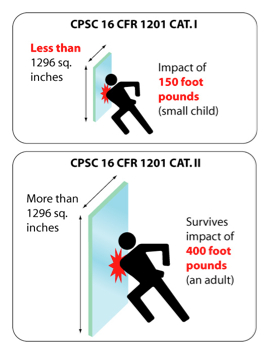Reduce liability and Save Lives.
This article discusses how school districts can replace unsafe wired glass and reduce liability by choosing clear, fire and CPSC safety rated glass products that outperform wired glass.
Schools built in the last century had little choice but to rely on traditional wired glass for fire protection. It was one of the only fire-rated glazing
options available. Unfortunately, traditional wired glass is not safety glass. In fact, wired glass breaks easily with minimal human impact.
The hardest thing to get across to most people, is the fragility of wired glass, said William O’Keeffe, founder and CEO of SAFTI FIRST. People see the wires and think they make the glass stronger. The opposite is true. Wired glass has less strength than, say, picture-frame glass.
In 1977, traditional wired glass was given an exemption from meeting the Consumer Protection Safety Commission’s (CPSC’s) impact safety standard when used in doors, sidelites and other potentially hazardous locations because glass manufacturers claimed that they did not have the technology to make fire-rated glass that could meet the glass safety standards. In the last decade, advances in fire-rated glazing technology led to safer, wire-free alternatives that provide both fire and impact safety. The International Building Code (IBC), which serves as a model for local building codes nationwide, was changed in 2003 to require that all glazing in potentially hazardous locations in educational facilities must comply with the CPSC safety-glass standards.
 |
Avoid Liability by Replacing Unsafe Wired Glass
Some school districts were alerted to the 2003 code change prohibiting the use of wired glass in hazardous locations. In March 2006, the New York State Education Department issued an advisory that said: “It has come to our attention that the 2003 International Building Code, which will eventually be adopted by New York State as the 2006 Building Code of NY State, requires that all glazing in impact areas in educational occupancies be impact resistant. This prompted us to research the issue and the results were quite startling. We strongly recommend that all existing wire glass locations be evaluated for potential impact and injury. There are several alternatives available to remedy locations determined to be at risk, such as replacement with impact and fire resistant materials, coating the glass with specialty films and installing protective bars or railings.”
In December 2003, Oregon’s state schools chief Susan Castillo sent out a memo alerting all superintendents that “documented instances of students being injured as a result of collisions with wire glass both here in Oregon and around the country.” According to a recent Multnomah County court case, the Portland school district doesn’t remember receiving this warning memo. The court found the school district to be negligent for a 2007 middle-school accident in which 13 year old Shakiya Sargent’s right leg pierced through the lower pane of wired glass on a fire door separating the cafeteria and the hallway. The jury verdict requires the school district to pay Sargent $222,000 in damages.
The Ontario School Boards Insurance Exchange tracks claims from injuries caused by unsafe wired-glass installations. The exchange reports that from 1987 to 2000, there were 107 claims against Ontario schools for glass injuries with costs amounting to $3,154,202. More important than the dollars is the pain and suffering, permanent reduced mobility and scarring caused by these impacts with glass, says the OSBIE website.
